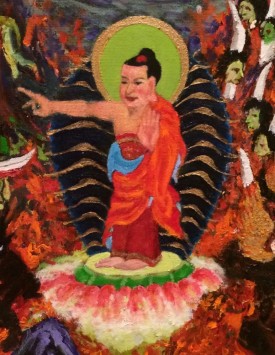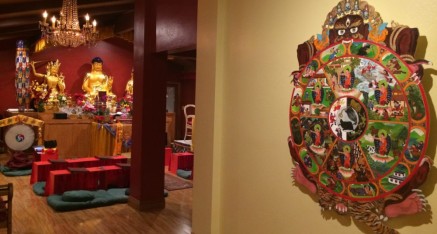A large mural of the Wheel of Life (Bravachakra) has been painted and installed in the temple by the artist Ci Guan. This image is a symbolic representation of samsara or cyclic existence, dating to the time of Shakyamuni Buddha. For over 2,500 years this has been a classic method of showing the basic teachings of the Buddha. In the painting, Lord Yama, looking ferocious and wearing a tiger skin, is holding the Wheel of Life with the twelve links of dependent origination around the rim. Inside there are living beings in the six realms of existence with the three poisons of avidya (ignorance), aversion or hatred (anger), and attachment or greed (lust) that keep us transmigrating around the wheel in the center as represented by a pig, a snake, and a bird. The pig symbolizes avidya or ignorance as it is considered the most stupid of all animals, while the snake represents aversion or anger as it is easily aroused and strikes at the slightest touch. The bird represents attachment or desire as the Indian bird usually used in these images is very attached to its partner. The bird in this painting is a pigeon, also known for its attachment and lust.
The second ring out has two-half circles: one is white showing happy people moving upwards to higher states of existence, even higher realms while the other dark half circle show people in miserable states being led downwards to lower states and the lower realms. This image represents karma or the law of cause and effect, whereby those going upward are experiencing the results of positive actions and those descending the opposite.
Other paintings often show the Buddha pointing to the moon outside of the wheel, which indicates liberation. The Buddha points to the moon to indicate that liberation from samsara is possible. In this painting, there is a Buddha in every realm pointing the way to help beings escape that level of existence. The Wheel of Life shows the consequences of karma and how we are forced to be reborn in one of the six realms according to our karma. There is no escaping this transmigration from life to life as a human, hungry ghost, hell being, animal, demi-god, or heavenly being unless one awakens to the truths of existence as Shakyamuni Buddha did and taught His followers to achieve. This image was given by the Buddha to his friend, King Bimbisara of Magadha to explain samsara to King Rudrayana (Udayana). The other king had given King Bimbisara a very expensive gift of a jeweled robe and King Bimbisara did not know how to return the favor with something of equivalent value. The Buddha painted this image (or had it painted) and told the King that there was no greater gift he could give his friend. It is said that the other king became enlightened upon receiving and studying the gift. It is also said that Shakyamuni Buddha instructed His monks to have this image painted on the walls of every monastery so that ordinary people could learn the true nature of samsara and how to escape it.
Samsara, the six realms of existence of ordinary or conditioned reality, is how the world appears to ordinary beings, while the Dharmadhatu is the absolute or ultimate reality or how the world appears to enlightened beings. The dharmadhatu is also known as the Buddha Lands of those who are beyond the cycle of birth and death. It is the land of the Buddhas and Bodhisattvas. Samsara consists of three spheres: the desire sphere of the hell beings, hungry ghosts, animals, humans, and some of the lower heavenly beings including certain devas or gods and demigods or asuras. In general, the first four categories all dwell in the desire sphere as do the lesser gods and demigods. In the form sphere, there are still gods who have form, but no longer have desire and in the formless sphere there is no desire or form, but only pure consciousness. Unless one can awaken to become a holy being, one cannot escape reincarnation in the six realms of samsara. Being reborn in the heavens as a result of living a good life and doing good deeds can be very blissful, but when one’s good karma is exhausted, one will still need to be reborn in the other realms to repay past karmic debts. A good human birth is considered the most favorable rebirth because, although there is still suffering and death, there may still be opportunity to learn the dharma, do good, and repay karmic debts and thus escape the cycle of reincarnation.
Click for more photos from the News Article from when the painting was installed.



